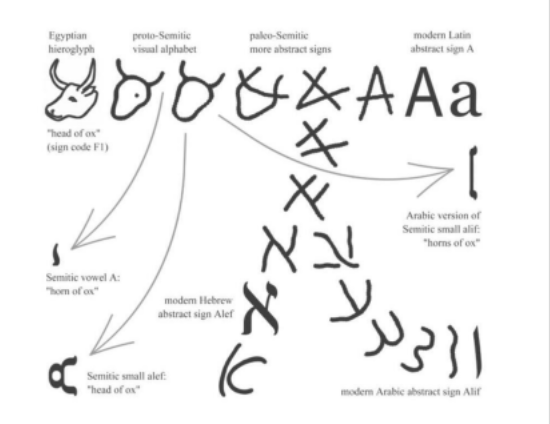
At the origins of dialogue between East and West: the invention of the alphabet
Aleph, alpha, aliph
Birth and migrations of writing
While archaeologists and historians date the birth of writing to the 4th millennium and place it in Mesopotamia (Iraq), it was in the 2nd millennium that the code for graphically distinguishing between the various ancient languages first appeared. The many archaeological and epigraphic remains found from the Fertile Crescent to the eastern shores of the Mediterranean bear witness to particularly dynamic migrations.
A veritable revolution in the history of mankind, the alphabet reflects the peoples of Antiquity: it was migratory because invented by traders. The Sumerian cuneiform alphabet was used to engrave accounts, transactions, inventories and property deeds in clay or stone. Its gradual evolution into a conceptual system, where the letter corresponds to a word, emerged in the region of present-day Lebanon: Phoenicia, but also in Palestine and on the Syrian coast.
A civilization of merchants and sailors, the Phoenicians reigned supreme over the Mediterranean and the Aegean, where they established trading posts. Inscriptions on ceramic fragments and funerary stelae attest to their presence as far afield as Sinai, with borrowings from Egyptian hieroglyphs.
It was also through their contact that the Greeks appropriated the alphabet and developed their own. Composed of twenty-two letters, the paleo-Semitic Phoenician alphabet is thus the matrix of all others, ancient and modern. Through Aramaic, it directly spawned Hebrew script in the 6th century BC (whose square letters attest to Babylonian influences and were used to write the Torah), then Arabic in the 6th century AD, in parallel with the writing of the Koran.
"Alpha-beth": from letters dialogue to cultures dialogue
It is through circulation of people, of languages, cults, and knowledge that civilizations open to other visions of the world.
In Egyptian, Phoenician and later Hebrew, the pronunciation and spelling of certain signs corresponded to the designated objects. For example, the letter a ("aleph") symbolizes and designates a head and then the horns of an ox; the b ("beth"), means "house"; the consonant "ain", common to Hebrew and Arabic, means "eye". They also have a numerical value (numbers were not invented by the Arabs until the 9th century) and, by extension, a mystical or philosophical value. In this way, the letter encounters thought.
This itinerary is reflected in the word "alphabet" itself, composed of the first and second Phoenician and Hebrew letters ("aleph" and "beth"). Barely transformed by ancient Greek into "alpha" and "betha", we find them again later, in Arabic, with "aliph" and "bha". The modern Latin alphabet, which derived from Greek, also adopted them. In other words, the alphabet's naming and transcription allow for linguistic and cultural re-appropriation and innovation.
In its wake, Jewish thought became Hellenized in Alexandria (some biblical books were even written in Greek, which became the universal language in the Mediterranean), and in medieval times, Western Europe gained access to ancient philosophy, thanks to translations by Islamic scholars. In both cases, transfers and mediations took place: from Hebrew to Greek and from Greek to Latin via Arabic.
From time immemorial, the alphabet and its numerous variations have written an inspiring and fertile tale of relations between East and West. And it invites us, even more so today, to cultivate the art of conversation and exchange.
Read more :
ATTALI Jacques, SALFATI Pierre-Henry, Athènes, Jérusalem, Le Destin de l’Occident, Fayard, 2016
Sources :
La révolution de l'alphabet | lhistoire.fr
L'hébreu : une langue sémitique et son histoire
Les langues sémitiques | unige.ch
QUE_SAVONS_NOUS_DES_LANGUES_SEMITIQUES.pdf



